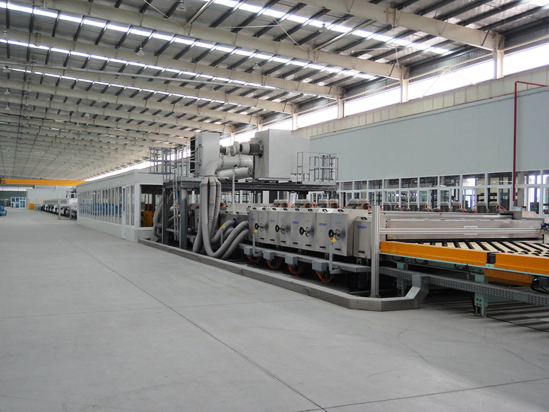View: Time: 2017-12-25 17:01:23
Glass production process
1, raw material preprocessing. The bulk material, such as quartz sand, soda ash, limestone and feldspar, is comminuted to dry the wet material and remove iron from iron containing raw materials to ensure the quality of glass.
2. Preparation of mixture. According to the difference of the product, the composition of the mixture is slightly different. For example, the common float glass batch (according to the 1 weight box, namely 50 kilograms), consumes 33.55 kilograms of quartz sand, 2.96 kilograms of limestone, dolomite 8.57 kilograms, soda ash 11.39 kilograms, Glauber's salt 0.55 kilograms, feldspar 3.45 kilograms, carbon powder 0.03 kilograms.
3. Melting. Glass mixture is heated at a high temperature (1550-1600 degrees) in a furnace or crucible kiln to form a liquid glass that is uniform, free of bubbles and conforms to forming requirements.
4. Molding. The liquid glass is processed into the required shape, such as flat glass, all kinds of utensils, etc.
5. Heat treatment. By annealing, quenching and other processes, the stress, phase separation or crystallization in the glass, and the structural state of the glass are eliminated or produced.
Production process of float glass
As an example, the manufacturing process of float glass is introduced as an example of the common daily melting of 600 tons in China.
The whole production line is about 500 meters in length and can produce 550 to 600 tons of glass a day, that is, the glass belt that is equal to 3 meters wide, 3 millimeter thick, and about 25 kilometers in length. Once the production is started, it is 24 hours a day uninterrupted, until about 8-10 years after the maintenance of the furnace. Float glass is made in tin grooves. Floating production is the main mode of production of flat glass today, and its process can be divided into five stages:
1, the mixture of raw materials. The main ingredients of the float glass are 73% silicon dioxide, 9% calcium oxide, 13% sodium carbonate and 4% magnesium. The raw materials are mixed in proportion and added to the recycled small glass particles.
2, the melting of raw materials. After a mixed storehouse, it is heated in a kiln with 5 chambers and becomes a glass melt at about 1550 degrees centigrade.
3. Glass molding. The molten glass flows into the tin bath and floats above the molten metal tin solution, at which temperature is about 1000 degrees Celsius. Glass melt on the tin liquid forms a glass band with a width of 3.66 meters wide and a thickness of 3mm to 19mm. Because glass has very different viscosity with tin, so the glass melt floating on the top will not mix with the tin liquid below, and form a very smooth contact surface.
4. The cooling of glass melt. The temperature of the glass belt is about 600 degrees centigrade when it leaves the slot, then it enters the annealing room or the continuous slow cooling kiln, gradually reducing the temperature of the glass to 50 degrees Celsius. The glass produced by the Hsu cold mode is also called annealed glass.
5, cut and store. The glass after the Hsu is checked by several stages of quality, and then cut into different sizes for packing, storing, or transporting.
Raw materials for glass production
The raw materials of glass production include two major categories: main raw materials and auxiliary materials. The main raw materials to the introduction of the glass network forming oxide (also called network formation, such as silica) and glass network structure over the intermediate oxide (also called network intermediates, such as three two aluminum oxide) and network oxide (also called network modifiers, such as sodium hydroxide); auxiliary materials include clarifying agent, fluxing agent, opacifying agent, coloring agent, bleaching agent, oxidizing agent and reducing agent and other industrial raw materials and chemical reagents.
According to different uses of glass, different production processes and different subsequent processing requirements, there are certain differences in raw material formulation, type, quantity, order of adding and adding methods.
The difference between ordinary flat glass and float glass
The common flat glass and float glass are flat glass, the difference is that the production process and the quality are different.
1. Production technology. Ordinary flat glass is a transparent, colorless flat glass made of raw materials in a certain proportion, fused by a high temperature and produced by vertical or flat drawing and calendering. Float glass is prepared according to a certain proportion, the furnace temperature, the glass liquid from the tank furnace continuous outflow and floats on the metal surface, uniform thickness, smooth spread into the fire polished glass, molten metal from cooling after hardening by annealing, cutting a colorless and transparent glass plate
2. In terms of quality. Ordinary flat glass according to the appearance quality is divided into superior products, first-class products, qualified three; according to the thickness of 2, 3, 4, 5 and 6mm thickness. Ordinary glass is green, fragile, transparent, and easy to age and deform under the rain. According to the appearance quality of float glass is divided into superior products, first-class products, qualified three; according to the thickness of 2, 3, 4, 5, 6, 8, 10, 12, 15 and 19mm thickness. The surface of float glass is smooth and smooth without ripple, with good perspective and a certain toughness.

. Structural Glass Curtain Walls
. What is color! Simple Talking ...
. Advantages and uses of toughen...
. Various glass defects and solu...
Office Addr:Room 1107, B1 Block, Tianan Cyber,Nancheng Area, Dongguan City, Guangdong Province, China,
Factory Addr:Taiying Industrial, Hongmei Town, Dongguan City, Guangdong Province, China
86-769-22273585
86-18145870793
![]()